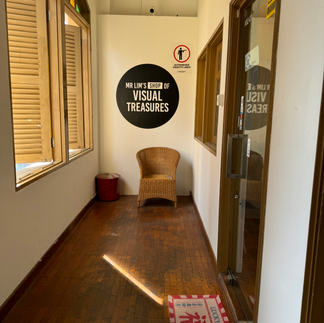Sticker Diplomacy
- Tallulah Patricia B
- Apr 17
- 9 min read
A Staircase in Singapore, a Room Full of Resistance, and the Kind of Conversation That Stays With You
To (he)art. To the city. To Mr. Lim.
by Tallulah Patricia
I came to Singapore to fill my cup.
Not to escape, but to shift pace. To remember what it feels like to move without urgency and listen without scheduling it. I’m still working here—on partnerships, platforms, and purpose—but I needed a different rhythm. A short, sharp Tapetenwechsel. Something to punctuate the endless scroll of productivity that had quietly started to flatten even my own sense of time.
Since leaving the corporate world, my life has expanded in ways I couldn’t have planned.
I create more. I connect differently. I dream—without suppressing the parts of me that never fit inside the system to begin with. But freedom comes with friction.
Mandates. Community building. Advisory work. Constant pitching. Constant context-switching. Structure is no longer imposed. It's self-made. Hustle is a daily muscle, trained everyday, flexing in all the right moments. It can get exhausting. Don't get me wrong. It's fulfilling—but it doesn’t always pay on time. Or at all.
This morning followed one of those long, unexpected nights that leave you slightly over-perfumed, under-caffeinated, and completely allergic to hard pants. A hangover you can’t exactly name—just a general sense of needing soft clothes and a softer day.
So I set out with one simple goal: caffeine!!
I don’t own a step tracker—I’m not that kind of person (lol). But as I wandered—through hawker centres, housing blocks, alleyways, and sidewalk cafés—I found myself mentally clocking the steps, not for health but for self-amusement and rhythm. For the satisfaction of seeing a city not from a car window or a business meeting, but from ground level.
Observation has a way of becoming its own kind of data. And my brain is constantly processing. Hence the writing....
I passed a hawker centre where retirees slurped soup in community or alone, surrounded by curry signs and cheap plastic fans doing their best. I particularly remember that one woman in a black tracksuit who had walked past me with a determined stare that suggested she knew exactly where she was going.
I didn’t. I roamed and wandered. I was watching—faces, textures, signage, pace.
A green mosque dome rose quietly above the clay tiles, as if to remind the neighbourhood of stillness. Just behind it, a sharp red-and-white HDB block stood like a lesson in both social policy and aesthetics: form, function, and government-engineered identity all folded into one.
Further on, construction cranes reaching towards the sky like half-drawn diagrams of Singapore's infrastructure ambition. Below them, a street lined with Cantonese restaurants, hot pot spots, reflexology and massage joints, and optical shops. Shiny glass towers pressed up against preserved façades like the perfect metaphor for the city’s tempo—optimised, historic, rich and complex.
It was all there. A slow-moving archive of Singapore’s contradictions (more on that soon...)
I walked for hours. Through alleyways that smelled like incense and fried dough. Through food courts that reminded me of what cities used to feel like before they turned into mood boards. Somewhere near a mosque around Arab Street, I paused. Not for prayer—though in hindsight, maybe I was praying for something real. Something that didn’t come with a receipt.
And then I saw the sign.
“LOVE ART? COME UPSTAIRS.”Mr. Lim’s Shop of Visual Treasures – Level 2
A stairwell. A taped note. Not curated. Just placed.
I hesitated. Then I went up.
I climbed the narrow staircase with the kind of reckless trust only solo female travellers and mid-life pivoters possess. What I found upstairs, Singaporean dust, a bamboo chair. silence.
And then— a portal.
A living, breathing, unapologetically cluttered cabinet of social resistance.
Not a fine art gallery.
Not a touristy trap shop.
Not really a studio.
Something else entirely.
A visual memory bank, capturing the contemporary and past Zeitgeist. A radical archive. A preservation of activist art and creative protests.
It was Mr. Lim.
Let me be clear. Mr. Lim is not a gallerist. He’s an archivist of humanity. A former advertising exec with a cancer scare and a collection of contemporary art that could eat MoMA for breakfast. The man had Ai Weiwei cut his hair for a performance piece and considers artists who paint with their testicles to be “kind of brilliant.” His words, not mine. But also… mine.
In his space—somewhere between flea market aesthetic and revolution headquarters—there are no white walls, no gallery assistants in turtlenecks, no QR codes for silent contemplation.
There are, however, sticker packs, mechanical sculptures, and silk-screened relics of political rebellions past.
And conversation. So much conversation. About censorship. About capitalism. About how Singapore paints over its graffiti only to approve identical murals months later—art as permission, expression as performance (to the Swiss reader, yes I know it reads familiar..).
Mr. Lim, who once hawked headphones and branding slogans, now spends his days giving outsider artists—some unhoused, some neurodivergent, some full-time mushroom sculptors—a literal and metaphorical wall. The gallery (if you can call it that) hosts everything from Ai Weiwei’s refugee Odyssey series to a hundred-dollar painting of a cat following a girl through a factory corridor. "She paints wherever the cat sleeps," he told me, as if that made perfect sense. And you know what? Later it did.
We talked what felt for hours. About art, censorship, repetition, preservation. We talked about surveillance capitalism, geopolitics, the exhaustion of overly curated polish. About how cities like Singapore—though pristine and efficient—can leave little room for the wild, the ugly, the undone (We still LOVE Singapore). We talked about the corporate world. How we’d both lived inside it. How easy it is to make something look important, and how rare it is to make something that actually is.
He pointed to a sculpture built from discarded medical equipment and zines. “That one,” he said, “was made by someone who sleeps on the floor of a print shop.”
There was no pity in his voice. Just respect.
There was no self-congratulation either. Just presence.
And that’s what added to my admiration Mr. Lim and his humanity. He’s not trying to go viral. He’s trying to make sure people—and their stories—don’t disappear. He knows the art world can be brutal.
Gatekeeping in the arts real. He fully understands that sometimes, survival looks like putting your work on a wall in a room above a noodle shop, and hoping someone curious enough takes the stairs. About all that gets lost when the market decides the story. He gave me a full tour of his two floored space.
Curating and story telling each piece. The story of the artist and the piece.
Sometimes even the story of how he got the pieces, or why.
Social, Anthropological, Economical and always quietly political.
Lim's space truly feels sanctuary of old treasuries, stories, whispers from artists who have shaped our century’s conscience.
We conversed about art, yes—but also about the geopolitics that frame art, diaspora experiences, colonial echoes, and the fragmented cultural makeup that gives Singapore its layered identity. Mr. Lim wasn’t just sharing knowledge. He is archiving emotional textures, sharing historical frequencies.
You really don’t meet people like that often. And when you do, your whole nervous system pays attention.
There were Shepard Fairey prints—including his iconic Hope poster of Obama, which Mr. Lim bought before the U.S. elections, “when no one believed he’d win.” That choice wasn’t just aesthetic. It was a political gesture. To believe in the icon before the world did. To invest in possibility.
There was Fairey’s Peace and Love Are Watching Over You—a delicate piece merging panopticon imagery with warm-toned graphic seduction. Surveillance never looked so sanctified. It made me question who sees, who guards, protects, and who gets to label dissent as terror or danger.
There were Hope for Darfur posters and relief series—raising funds, yes, but also consciousness. These weren’t charity commodities. They were campaigns disguised as prints. Mobilization through aesthetics.
Next drawer: Daniel Johnston—I felt ignorant. Didn't know of him. He explained. An outsider, visionary, schizophrenic prophet of lo-fi American art. His hand-drawn pieces felt almost too personal to be seen. Raw cartoons, existential comedy. “I’m so tired,” one figure says, as another shouts, “Wake up!”
The way Lim spoke about the pieces in this sacred room signaled something real and rare: emotional honesty as archival value.
Then came the anonymous migrant scroll—a powerful visual timeline of movement, border policing, and refugee bodies. Thousands of inked figures, walking in procession, pushed into boats, caught at wire fences. #SafePassage. Open the Border. A reminder that art can scream without volume.
There was satire too—one piece showed anthropomorphic flies smoking, fighting, fucking around a giant banana and backside. Grotesque but pointed. A critique of media hypersexualisation? A riff on consumption? Probably both.
And tucked deeper in the flat files: bold blocks of red and pink by KAWS. He owns so much of KAWS. Shapes that shout before they explain. KAWS is overly commercial, yes—but also a cultural signpost. Street art’s commodification. Nostalgia as market logic. The way play becomes brand.
Another series of canvases stood out to me. He told me about one woman, whose works Lim showed me reverently. She is a squatter, squats in abandoned factory buildings across the island. It shook me. Singapore has hidden poverty—just like any other global city. He revealed that this incredibly talented artist lives, survives with and through her art, with severe mental health challenges. In one canvas, she painted the path her fellow squatter cat took through their shared space. Almost like art as ritual. A daily map. A way to stay sane, seen, and present.
Then, Vasan Sitthiket: Thai artist, poet, and political agitator.
Woodcut prints signed and numbered, priced modestly, bearing scenes of lovers entwined, suns and moons watching. They were raw, tender, unfiltered. His reputation spans continents—from the Venice Biennale to MoMA—and yet his work here felt deeply grounded, almost personal. As if protest, for him, was both public act and private prayer.
He shared the story of another Singaporean artist he knows, a muralist, had once been allowed to paint a striking portrait with three eyes—only to be told by authorities to erase one. “Someone might complain...” She later moved to Bali.
The erasure wasn’t just physical. It was symbolic. A reminder that visibility in sanitized cities comes at a cost. You can be creative—as long as your vision stays within the lines.
These stories weren’t sidebar anecdotes. They were so grounded and at the core. It became so clear to me that Mr. Lim doesn’t curate to impress. He archives to remember. Shares out of passion. Sells to support and curates because it's part of who he is. How and what he lived and experienced.
When he showed me his graffiti collection—his “urban art” drawer, as he called it—I laughed. Isn't all of it urban art in the end? He seemed to appreciate that. I told him about Oibel. Zurich-based. Afro-Swiss. Graffiti, stickers, murals, energy. I said he was one of the few whose work didn’t try to be anything but what it is: loud, bright, free.
As I left, I felt something shift. Maybe it was the caffeine finally kicking in, or maybe it was the reminder that the most powerful connections are rarely scheduled. They're stumbled into—between Mezcal hangovers and holy places, between buses and backstreets, between a staircase and a second floor gallery in Singapore.
That day, I wasn’t just a visitor. I was a witness.
I left (with two art pieces).
But it wasn’t until I walked back—a few moments later , still riding the high of that unexpected connection—that it happened.
I remembered the stickers.
I remembered that Oibel had given me a big batch of three different ones. Bold lines. Layered color. Joy. “Spread love,” he said, as he handed them to me. He always says that. That’s the mission: paint joy, plant memory.
I didn’t take them to Singapore by accident. I knew I’d find the right place. The right person. I knew some will be given to my Singapore residing friend who loves art. Maybe for a street sign (but I also remembered the panopticon effect—and the fear of getting deported or arrested for vandalism was real). Still, in the back of my mind, I knew I was meant to give one to someone who got it.
When I paused outside the gallery, I checked my bag. There they were—neatly slipped between the pages of my black leathery travel notebook, nestled next to an old Credit Suisse pen I barely touched since walking out of that life. The juxtaposition made me pause.
Almost poetic—Legacy and liberation. Sticker and system.
I climbed the stairs again.
Mr. Lim looked up. I said nothing. Just smiled, and handed him the sticker.
He nodded with a knowing joy—and then said, “I would like to give you some of mine too.”
He reached behind the desk—slowly, carefully—and pulled out a few stickers of his own.
“These have travelled too,” he said.
Then he paused.
“Sticker diplomacy.”
We both laughed.
It was more than a phrase. It was the perfect summation of everything we’d just shared all afternoon.
Two human, from two different cities, two acts of care disguised as exchange. The stickers weren’t the end—they were an extension. Of recognition. Of preservation. Of love that moves through paper, pigment, and presence.
Mr. Lim is now clinically blind—he told me that early in our conversation. He doesn’t see much anymore. But he still feels all of his art. He knows where everything is. What it means. What it holds.
And when we touched to say goodbye—his hand on mine, deliberate, still—I knew he had seen me.
Fully.
Not with eyesight. But with presence.
Not everything needs to scale.
Not everything should.
Some things are supposed to stay underground—until someone climbs the stairs and sees them.
And sometimes, that someone is you.
And when you’re lucky, you leave behind more than a thank you—you leave a sticker.
You spread love.
I didn’t just leave with stickers and paintings. I left with something harder to define: the echo of a conversation I didn’t know I needed, and the permission to continue walking without knowing exactly where I'm headed.
Because maybe this is what sticker diplomacy is really about: the small, defiant act of showing up—with curiosity and no agenda— just an open heart and mind.
Thank You Mr. Lim.
Until we meet again.

















































































Comments